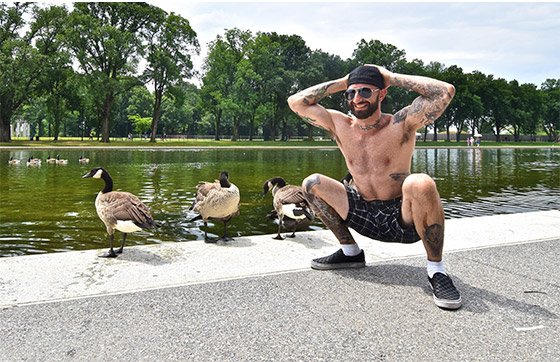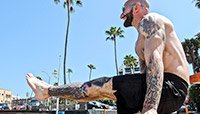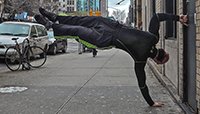During a recent workout at my local park, I observed a father and son playing a game of catch. The dad was around my age, and the boy looked to be about 3 years old.
At one point the child missed the ball and the dad went to retrieve it. I watched him bend down with his back rounded, shoulders slumped, and knees pitched way over his feet—what you might call "bad form" on a squat.
A few minutes later, the boy missed the ball again, but this time his dad let him retrieve it himself. When the tot picked up the ball, he squatted down from his hips with his chest tall and lifted without the slightest bend in his back—or any overt awareness of the movement pattern he'd just performed. It happened very naturally. He certainly had no idea that what he'd just done feels all but impossible for most of my beginning personal training clients.
Squatting is one of the human body's most fundamental movements, yet through years of neglect, many adults have forgotten what once came effortlessly. Children instinctively perform perfect squats, but most adults have spent our lives sitting in couches, chairs, and cars, all of which steer our bodies away from natural squatting. We've done this to the point where we've unlearned instinctive habits—like lifting from the legs—and replaced them with lower back pain and hip ailments.
Though we live in a world where most people spend many of their waking hours in some sort of chair, it is not too late for you to relearn this primal movement pattern. Yes, you can still squat—and you should! Here's how you're going to get back down where you belong.
How Low Can You Go?
Relearning the squat isn't as simple as doing a few thousand bodyweight squats for reps. Newcomers and people with limited mobility might not be able to get very deep into a squat without dramatically sacrificing their form. This is to be expected, but let's set some boundaries of what constitutes a safe squat.
I don't mind if your knees track forward of your toes a little, but you always want to be sure your heels are flat during squats, with weight evenly distributed throughout the feet and toes. On the other hand, I always grant a bit more leeway with spinal positioning on bodyweight squats than the kind where heavy weight is loaded on your back. It's OK to bend forward at the bottom of a bodyweight squat when you're working on mobility rather than strength.

In time, the plan is to be able to squat with a tall chest and straight back until your hamstrings come into contact with your calves in the bottom position. This is what's known as "ass to grass" squatting, although I prefer the more accurate "ass to ankles."
The tall chest and straight back part might take a while, so until that's possible, just stay as upright as you can.
If you're having a hard time keeping your heels down, I suggest holding onto a doorframe or other sturdy object for support. Hold on tight, but try to keep your shoulders relaxed as you sit back onto your heels, sinking down as deep as you can.
While keeping your heels planted, start to think about flexing your ankles so your knees track forward in line with your toes. Over time, you'll learn to gradually rely less on the support of the object and begin to find the bottom of a deep squat without needing support.
Hold it Right There
If you're unable to get into an unsupported full squat with your calves resting against your hamstrings, I recommend starting a daily stretch routine to help restore a full range of motion. Morning, evening, and pre-workout are all good times As long as it gets done, it doesn't really matter when you do it!
Warm up with 10 or 20 slow, deliberate bodyweight squats. Once you're done with these, sink down into your deepest possible squat position and hold it right there, grabbing onto your sturdy object if necessary. Right away, you'll feel a big stretch in your hips, groin, calves, and maybe even your ankles. This is good. Take a deep breath and try to relax into it. Hold this position for one minute at first, and gradually work up to holds of several minutes or longer.
After practicing for a few days or weeks, you should begin to feel more comfortable in this position. Eventually this can become a resting position that you'll be able to stay in for extended periods of time. That's when you'll really start to see the benefits of reclaiming your squat, such as increased hip and ankle mobility, improved spinal health, and improved knee health.
You'll also be able to use better technique on strength-building squat variations, allowing you to build more powerful legs through a full range of motion.
Hips, Hips, Hooray!
When you're down there holding your deep squat position, there are a few other things you can do to further facilitate opening your hips and spine. One of my favorite techniques it to place my hands in a prayer position in front of my chest and press my elbows against the insides of my knees in order to leverage them open for a deeper hip stretch. Again, resist the urge to tense up. Breathe deep and try to relax into the stretch.
My other favorite thing to do is to practice spinal rotation while in the deep squat position. Try reaching one arm into the air and looking up at your hand. Then lift and open your chest toward the sky.

Feel free to place your opposite hand and arm on the floor, or against your leg, to help leverage yourself toward a deeper twist. As you get more mobile, you can work toward binding your hands around your knee to add a shoulder stretch as well. Make sure to practice this type of spinal rotation evenly on both sides.
If you feel that practicing these holds on a daily basis may be too much for you, start out doing them every other day and eventually work toward a daily practice. In time, you may even find yourself dropping into a squat instead of a chair next time you need a rest.
Recommended For You

7 Ways To Maximize Your Strength And Speed
Calisthenic training doesn't end with push-ups, pull-ups, and pistols. Advanced practitioners pack the Internet with showy moves that boggle the mind and set the bar ever higher. Here are 5 visual feats you should consider putting in your sights!
STRETCHING FOR STRENGTH
Reports of stretching's demise have been greatly exaggerated. In this excerpt from Al Kavadlo's new book, the bodyweight training chief helps you build an effective, personalized practice!


